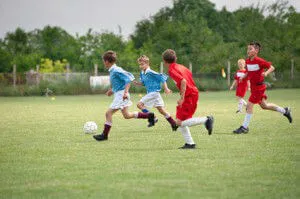Due to our nation’s strained economic situation, many schools have faced significant budget cuts. Sadly, gym classes in schools across the country have taken some of the biggest hits, and our children are much worse off in their absence.
Depleting physical education programs is counterproductive to education as a whole, because, along with helping kids maintain healthy bodies, new research shows that exercise actually helps improve academic performance.
In June of 2012, the Centers for Disease Control and Prevention (CDC) reported that almost half of the high school students in the United States had no physical education classes in an average school week.
An investigation of San Francisco elementary schools by researchers at the University of California, San Francisco revealed that only 20 percent of the schools were meeting the state exercise requirement of 20 minutes per day for elementary school students.
Jeff Engel, a vice principal at Long Island City High School in Queens, says, “there does not appear to be a promotion, or support, from the Department of Education for daily physical education in many of our high schools. We have a huge obesity epidemic in the city, yet we see many of our high schools going to non-daily physical education.”
Besides being a powerful tool in the fight against childhood obesity, physical education programs have been shown to actually help children learn. One large study of nearly 12,000 Nebraska children found that better physical fitness was linked to notably higher state standardized test scores.
This study also found that overweight students with higher fitness scores did better on the tests than lighter students with lower fitness scores. Physical activity, it seems, is more important than body size when it comes to academic performance.
Another study performed at the University of Illinois at Urbana-Champaign compared the aerobic fitness of 9 and 10 year old boys and girls against their ability to perform memorization tasks. The aerobic fitness of the children was first tested by the researchers via a treadmill test, and then 24 of the most fit children and 24 of the least fit were asked to complete a memorization exercise.
The children were given an imaginary map with four-letter region names to study, and were asked to fill in the names of the regions on a blank map the next day. Some of the children were quizzed on the region names while memorizing them, and some of them simply studied the maps without any quizzes to test their knowledge as they studied; a learning method that researchers have found to be more challenging.
Results of the imaginary map test found that the children that had been quizzed while studying achieved similar results, whether they were considered physically fit or not. However, when the children who had not been quizzed while memorizing were tested, researchers found that the physically fit children performed about 15 percent better than the least fit children.
The authors of the study wrote, “higher levels of fitness have their greatest impact in the most challenging situations.” The study’s co-author, Charles Hillman, recommended “at least an hour a day” of aerobic physical activity for children in order to enhance their learning capabilities.
Until our government recognizes how essential physical education programs are to our children, and provides more funding for their needs, many of our schools continue on without sufficient gym classes. However, this is all the more reason for parents to make sure that their kids get proper exercise at home.

If your children are active at home, any exercise they receive at school will be a bonus, and not their only source of movement. You may well see the positive results reflected in their test scores, as well as their physical health.
-The Alternative Daily
Sources:
http://well.blogs.nytimes.com/2013/09/18/how-physical-fitness-may-promote-school-success/?ref=health
http://www.ncbi.nlm.nih.gov/pubmed/23465408
http://www.plosone.org/article/info%3Adoi%2F10.1371%2Fjournal.pone.0072666
http://www.nytimes.com/2012/07/11/education/even-as-schools-battle-obesity-physical-education-is-sidelined.html?pagewanted=all
